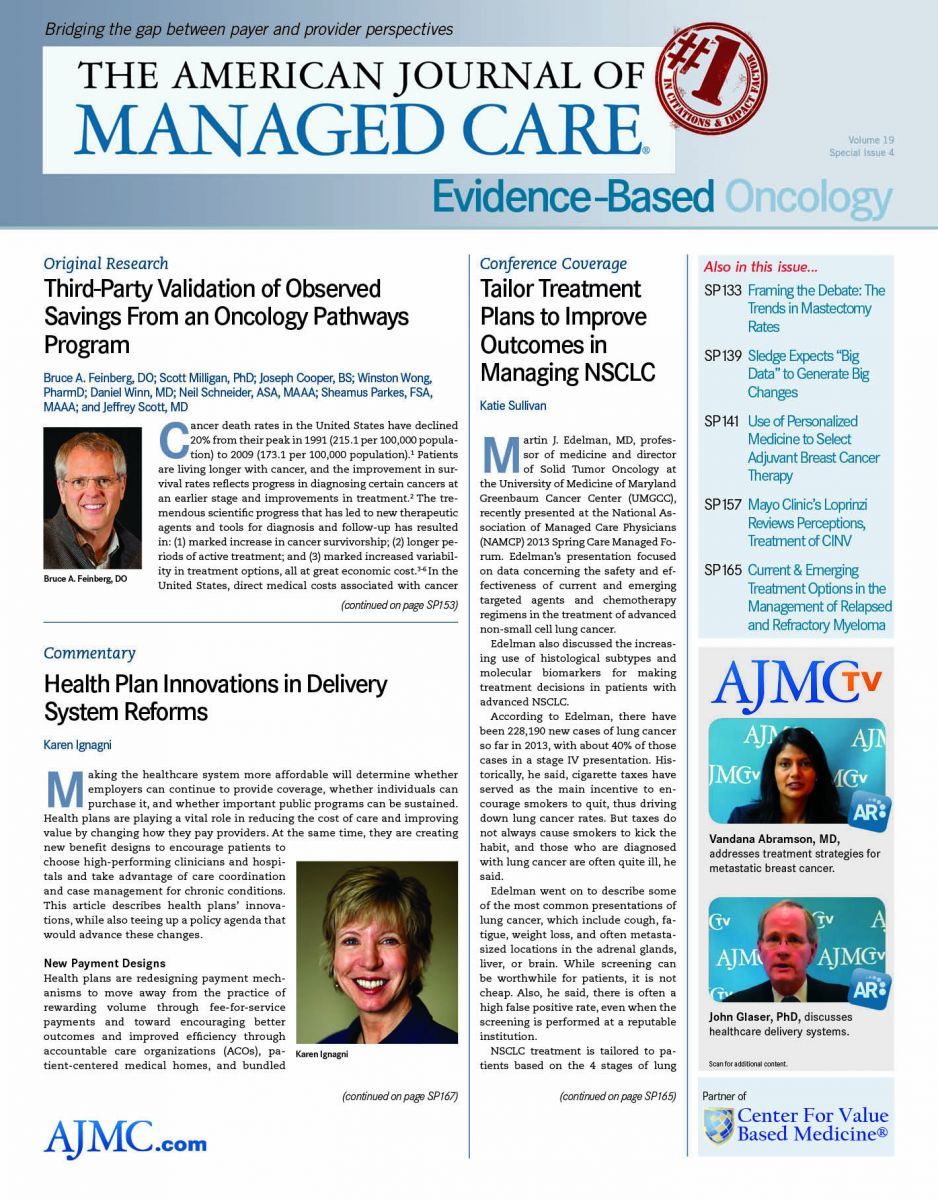Publication
Article
Evidence-Based Oncology
The Changing Landscape of Oncology: Impact for Payers and Providers
Author(s):
Cancer. The word strikes fear as a clinical diagnosis. It also keeps managed care and employer medical directors up at night, wondering what the future will bring and how they will manage cancer coverage in the context of the limited dollars available for all medical care and diseases.
As a disease, cancer is complex, evermutating, and elusive to pigeonhole into any 1 solution or description. The same can be said of the business of oncology. Sweeping innovation and changes in site-of-care delivery, the quality discussion, evolution of data and management models, and the management of oncology drugs mean that oncology care and management relationships between providers and payers look different in every state, city and local market. We will continue to see wide variation for the foreseeable future. However, 1 common denominator is emerging in oncology landscape success stories: collaboration between providers and payers.
The biggest challenge for effective oncology management is that oncology care is not just about the drugs. Most managed care oncology policy today focuses on drugs: prior authorizations,step edits, formularies, preferred fee schedules, etc. However, most health plans and employers, if they were to analyze their total spending on cancer care, would learn that only about 20% to 30% of that spending is on dollars paid for treatment in community offices (for both medical services and drugs).1
The other 70% to 80% of the total cancer spending goes to hospitalizations, labs, imaging, other diagnostics, hospice, and hospital-based services. However, almost all of those dollars result from complications of the disease, as well as human reaction to the symptoms and side effects of both the disease and the treatment itself. All this is, or can be, affected by the treating physician, as well as the treatment choices made with and by the patient during the journey through cancer, whether the cancer or the patient wins the battle.
Perspective is everything, and oncology management cannot be done in a vacuum. Providers and payers look at the aspects of oncology management from 2 distinctly different perspectives and, more importantly, with 2 distinctly—and historically unshared—sets of data. The physician/provider sees the patient on a one-on-one basis, understands the nuances of the disease and what is happening, as well as what treatments and side-effect profiles may best fit patients and their goals. The payer holds the data on the total costs of care, not just for individual patients, but for all patients with cancer, from all different care sites and treatment choices.
The National Association of Managed Care Physicians (NAMCP) is expanding the dialogue between the diverse perspectives of the provider and the payer. Its membership of medical directors from health plans, employers, and integrated care systems creates an opportunity for enhanced cooperation, collaboration, and communication across the disparate perspectives. Three major 2012 initiatives illustrated the variation in perspectives and the value of shared focus.
First, NAMCP turned to its own payer community for needed perspective on the total costs of care. NAMCP worked with the Community Oncology Alliance, (COA) and its members to analyze 3 years of payer and employer data (in a protected, deidentified environment) and examine how the total cost of cancer care, as seen by the payers, varied by different care delivery sites. This was important information, due to changes in local markets shifting from private practice—based care to hospital-based care.2 The results clearly showed that cancer care delivered in larger hospital-based institutions is more costly overall than care delivered in private oncology settings, helping payers see that programs supporting private oncology settings could prove to be very cost-effective in the long term.
Then it was time to look at information held in the provider charts, which would have significant cost implications for payers. NAMCP embarked on a study of treatment choices and variations, based on details found only in the oncology practice electronic medical records. This would help its payer and employer members understand how the complexity of cancer patient health status could raise their total costs, if suddenly coverage policy were to shift away from physician acquired drugs, a practice known as “buy and bill,” to a delivered-drug model, also called “ship for ‘scrip,” short for prescription. Delivered drugs are billed to the payer upon shipment whether or not they are ever actually used in treatment, and drugs bought by the provider are billed to the payer only after they are actually used in treatment. Treatment options on a given day can vary based upon changing patient health status; thus, there is a significant potential additional cost to payers and society if future coverage choices are mandated away from “buy and bill” to “ship for ‘scrip.’”3
Not only would payers end up paying for a drug that was shipped and unable to be used for another patient or returned, but society would pay due to the lost opportunity of valuable cancer drugs that were issued to an individual patient, not used, and then slated for destruction rather than available for another patient. Any drug, once issued and labeled to an individual patient, cannot be returned or reused for any other patient; under most national and local pharmacy regulations, the drug must be destroyed (with the inherent additional costs of transporting and destruction.)
Most recently, it became clear that there was a large unmet need among medical directors of payers and employers, who usually are not trained oncologists but who are affected by changes in the oncology marketplace in their jobs and oversight expectacleartions. This group needed to obtain a comprehensive neutral overview of the rapidly changing oncology landscape—a context and support for the complex decisions needed to made. NAMCP responded with the 2013 NAMCP Medical Directors Guide: Oncology.4 This guide and a related slide deck can be used internally to prompt new policy and coverage decisions in payer and employer organizations, and to spur new communications and initiatives with providers in their communities.
1. 2011 Medical Pharmacy and Oncology Trend Report. ICORE Healthcare. Page 28. http://www.icorehealthcare.com/icore-resources/trend-report.aspx. Accessed December 28,2012.
2. Total cost of cancer care by site of service:physician office vs outpatient hospital. Avalere Health, Inc. http://www.avalerehealth.net/news/2012-04-03_COA/Cost_of_Care.pdf. Published March 2012. Accessed December 31, 2012.
3. Holcombe D, Force R, Bradley K, Conoshenti J, Huff K. Impact on health plan cancer drug costs in different delivery models. Journal of Managed Care Medicine. 2012;15(4):69-80.http://www.namcp.org/Journals/JMCM/Articles/15-4/PullDowns/Info%20CancerDrug-Costs.htm.
4. National Association of Managed Care Physicians Medical Director’s Guide. Oncology. http://www.namcp.org/Journals/JMCM/Articles/16-1/PullDowns/Info%20JMCM_16-1_Supplement.htm. 013;(16):1:1-32.
We have learned that true reform and movement toward quality and cost-effective care at the right time, in the right setting, with the right treatments and providers, for the patient, payer, and employer will only happen through coordination, communication, and collaboration between payers and providers. Individual projects and pilots are proving that to be true across the country. Our next challenge will be to address scalability, but, given the extreme diversity and cultural differences of the medical communities across the country, we are very likely to continue to see variation in solutions, although the approach and willingness to sit at the same table and analyze, review and create new oncology management policy together, is not likely to vary.





